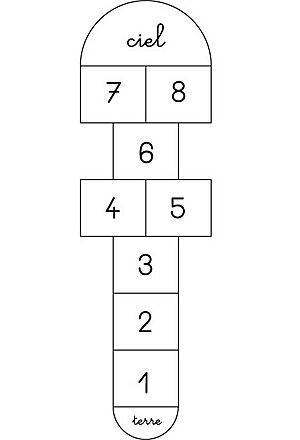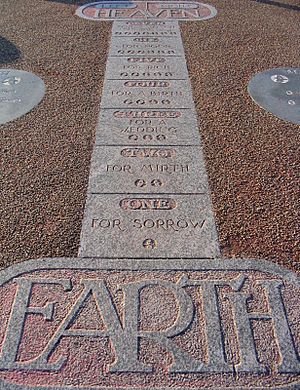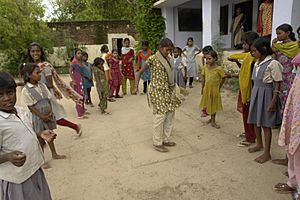Hopscotch facts for kids
Hopscotch is a fun children's game that can be played with friends or even by yourself. It's a popular playground game where players throw a small object, like a stone, into numbered squares drawn on the ground. Then, they hop or jump through the squares to get their object back.
Contents
How to Play Hopscotch
Hopscotch is easy to set up and play. You just need a flat surface and a small object to toss!
Drawing the Hopscotch Court
To start, you need to draw the hopscotch court on the ground. You can scratch it in the dirt or use chalk on pavement. Sometimes, courts are already painted on school playgrounds.
The design can change, but usually, it has a series of single squares followed by blocks of two side-by-side squares. At the end, there's often a "safe" or "home" base. This is where players can rest before heading back. The home base can be a square, a rectangle, or a half-circle. Each square is numbered in the order you need to hop through them.
| Hopscotch Courts, around 1900. | ||
|---|---|---|
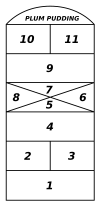 |
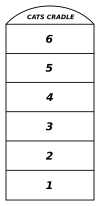 |
 |
|
|
|
|
Playing the Game
The first player throws a small marker, like a flat stone or a coin, into the first square. The marker must land completely inside the square without touching any lines or bouncing out.
Next, the player hops through the court, skipping the square where the marker landed.
- When there's a single square, you hop on one foot. You can choose which foot to use for the first single square.
- When there are two squares side-by-side, you straddle them. Your left foot lands in the left square, and your right foot lands in the right square.
- Squares marked "Safe," "Home," or "Rest" are neutral. You can hop through them in any way you like without a penalty.
After reaching the "Safe" or "Home" square, the player turns around. Then, they hop back through the court the same way. When they reach the square just before their marker, they stop. They bend down to pick up the marker, making sure not to touch any lines or step into another player's square.
If a player successfully completes the whole sequence, they continue their turn. They then throw the marker into square number two and repeat the process.
Losing a Turn
A player's turn ends if they:
- Step on a line while hopping.
- Miss a square.
- Lose their balance.
Players start their next turn from where they left off. The first player to complete a course for every numbered square on the court wins the game!
Historically, in some versions, especially for boys, the marker was kicked back through the course instead of picked up.
History of Hopscotch
People believe that an early form of hopscotch was played by Roman children a very long time ago. However, the first written records of the game in English come from the late 1600s. Back then, it was often called "scotch-hop" or "scotch-hopper(s)."
One old book of games from between 1635 and 1672 mentions "Scotch Hopper." It says people played with a piece of tile or lead on a floor divided into oblong shapes. In 1677, an almanac (a type of yearly calendar book) also talked about "Scotch-hoppers" as a game for schoolboys.
The name "hopscotch" comes from combining "hop" (to jump on one foot) and "scotch." The word "scotch" here means "an incised line or scratch." So, it's about hopping over lines drawn on the ground.
Hopscotch Around the World
Many countries have their own versions of hopscotch! Here are a few examples:
- In India, it's called Stapu, Nondi (Tamil), or Kith-Kith.
- In Spain and some Latin American countries, it's rayuela, golosa, or charranca.
- In Turkey, it's Seksek (which means "to jump with one foot").
- In Russia, it's классики (klássiki), meaning "classes."
- In Poland, it's klasy (classes) or pajac (buffoon).
- In Sweden, it's hoppa hage (jumping the garden).
- In Norway, it's paradis (paradise).
- In Italy, it's campana (bell) or mondo (world).
- In the Netherlands and Flanders, it's Hinkelen.
- In Bosnia, Croatia, and Serbia, it's školica (little school).
- In Malaysia, the most popular version is tengteng.
- In Mexico, it's bebeleche (drink milk) or avioncito (little plane).
- In Cuba and Puerto Rico, it's "La Peregrina" (Pilgrim Girl). The squares represent steps a pilgrim takes to reach Heaven.
- In Romania, it's șotron.
- In Brazil, it's amarelinha.
- In the Philippines, hopscotch is called "piko" or sometimes "kiki."
- In South Korea, it's "ttangttamŏkki" (Scoring Land).
Laylay (or Khane bazi)
In Persia, the game is called Laylay. A common version uses six or more (always an even number) squares in a line. Players kick a peg or flat stone to the next square as they hop. If the stone or a player's foot lands on a line, they lose their turn.
Peevers or Peever
In the Glasgow area of Scotland, hopscotch is called "beds" or "Peever(s)." The "peever" is the object slid across the grid. In the past, people often used a shoe polish tin filled with stones as their peever.
Escargot
This is a French version of hopscotch, also known as marelle ronde (round hopscotch). It's played on a spiral court. Players must hop on one foot to the center of the spiral, then hop back out.
If a player reaches the center without making a mistake, they can mark one square with their initials. From then on, they can place both feet in that square, but all other players must hop over it. The game ends when all squares are marked, or no one can reach the center. The winner is the player who "owns" the most squares.
Himmel und Hölle
In Germany, Austria, and Switzerland, the game is called Himmel und Hölle (Heaven and Hell). The first square is often called Erde (Earth). The second-to-last square is Hölle (Hell), and the last one is Himmel (Heaven). Players throw a stone into the first square and kick it through the course. They try to skip over the "Hell" square because neither the stone nor the player can stop there.
Kith-Kith
In India, besides Stapu, it's also called Kith-Kith in Hindi-speaking areas. Other names include Ek-hat - Du-hat in Bengal, Chirpi in Maharashtra, Kunte bille in Karnataka, Paandi in Tamil Nadu, and Tokkudu Billa in Andhra Pradesh and Telangana. These games all involve hopping on one foot and throwing a marker into the correct square. It's mostly played by girls in India, but some boys play too.
Potsy
In New York City, hopscotch was often called Potsy. This name likely comes from "potsherd," which is a piece of broken pottery that might have been used as a marker.
Australian Hop Scotch
In Australia, hopscotch has stages.
- Stage 1: Players hop using the standard rules.
- Stage 2 (Jumps): Players jump into each square with two feet.
- Stage 3 (Sizzles): This is the hardest stage. It's like jumps, but players cross their legs when they jump.
The first player to finish all three stages wins. If a player touches a line, they go back to the start of their current stage. Younger players can use "helps," which are extra lines drawn on the sides to make throwing the marker easier.
Rayuela
This is the name of the game in countries like Argentina, Costa Rica, Ecuador, Guatemala, Honduras, Nicaragua, Panama, Uruguay, and Spain.
Images for kids
See also
 In Spanish: Rayuela (juego) para niños
In Spanish: Rayuela (juego) para niños




